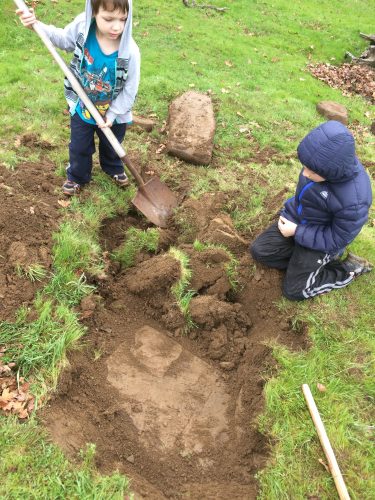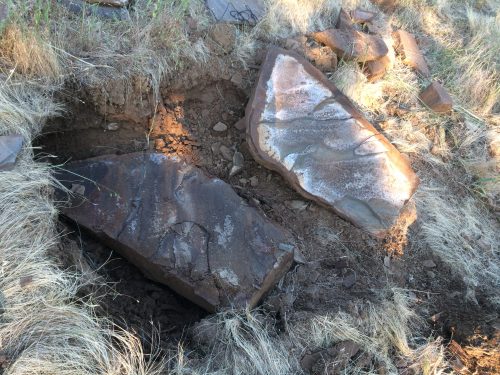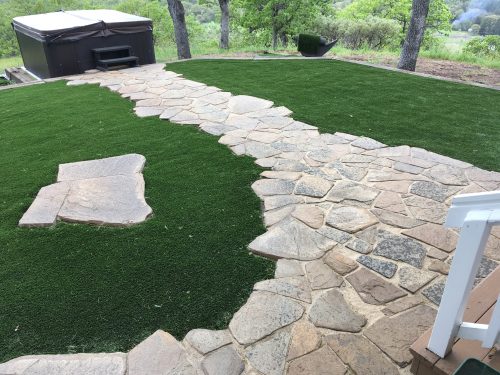This is the story of how I turned this:
into this:
and how it only took me 411 days.
It all started when I pried some flagstones out of the hill next to our house. They were sticking out of the grass, and I thought I’d use them for a path somewhere.
As I pulled stones out of the grass, I noticed that there were more stones underneath. My sons and I decided to investigate, so we dug into the hill to see what we could find.
We found lots of rocks — fat rocks, skinny rocks, rocks who climb on rocks.
Some of them looked really interesting too. Lots of colors were represented: tan, gray, slate, blue, red, orange, purple. (Just like the ol’ rainbow acronym: TGSBROP.)
Once we found that there was a seemingly unlimited supply of these stones in our hillside, we decided to make an entire patio out of them. Before my wife could change her mind, I stripped the woodchips from the side of our house in preparation for laying down stones.
I had to move some dirt around to level it and get it down the appropriate height down to allow for space for the sand and gravel foundation.
In other parts of the yard, I had to add dirt to get it up to the correct height. I ordered a load of topsoil and a willing helper.
Some parts of the yard needed to be raised as much as 18 inches, so I set up some guides to let me know when I had the dirt high enough. This didn’t work especially well, but it did work.
Of course, when adding dirt, you need to compact it. I bought a hand tamper from Home Depot and started compacting.
Two days and one case of carpal tunnel syndrome later, I bought a mechanical compacter instead. This allowed me to finish this part of the project before I die due to the heat death of the universe.
Because the edge of the patio would be a foot and a half above grade in some spots, I bought some railroad ties and used them as a retaining wall around the edge.
I secured the bottom run of ties to the dirt with 24″ rebar and the top ties with 12″ galvanized spikes (into the bottom ties).
While I was preparing the site, I was still digging out stones from the hill, and they were getting bigger as I dug deeper.
Some of the larger stones were too heavy to carry up the hill, so I had to either break them in half or pull them up on a makeshift sled.
By Memorial Day (of last year), I had the dirt leveled out and all of the railroad ties installed.
I had a couple of extra railroad ties, so I built a pad for a hot tub we were considering buying.
By this time, I had been mining our hillside for three months and had amassed a sizeable collection of stones. I did a double-take when I noticed I had accidentally arranged them like this:
I ordered a load of gravel and a load of sand. Laying these down on top of the dirt should ensure that water doesn’t pool underneath the stones and cause problems, especially during freezing/thawing times of the year.
I rented a Bobcat to make the chore of moving the gravel and sand a weekend job instead of a rest-of-my-life job.
Well worth the money.
Now that I had the soil leveled and covered with three inches of gravel and two inches of sand, I could start laying the stones down.
As I continued to lay down more stones, the building inspectors stopped by the check my work.
Here’s an overhead view from around the time I stopped working on the patio last fall. As school started up and the weather got colder and rainier, I lost a lot of motivation.
In the spring, I kept digging up stones, and again, they kept getting bigger.
Maybe too big… I broke my shovel trying to pry this one out.
This is the point that I gave up on the idea of covering the entire patio in stone. It was taking far too long to dig up enough stone to cover the entire patio, and I was getting tired of hauling them up the hill.
Plan B: artificial turf. Fake grass has come a long way from the plasticky Brady Bunch sod of my childhood; Costco sells a brand called Pregra that is easily mistaken for real grass once it’s installed.
It came in two 25-foot rolls, which each weighed about a million pounds. I wrestled them over to the patio, unrolled them, and cut them to fit the space.
While the flat grass look is classic, I wanted to try something more reminiscent of rolling foothills, but I was overruled.
After cutting the turf, I secured it to the ground with landscaping spikes and then filled the spaces between the stones with Polysweep, a polymeric sand. It’s like sand, but it hardens once it gets wet.
Here’s a better shot of the dried Polysweep and the pad for our fire pit.
The last step for the artificial turf was to add infill to puff up the grass and give it some extra durability. I used four hundred pounds of play sand, and I spread it with a grass seed spreader.
After spreading the sand, I brushed it in with a push broom, and then I wrote a perfect segue into the end of this post.
If you scrolled to the bottom hoping that instead of reading a boring write-up, you could watch a timelapse of the entire process, you’re in luck. Enjoy!
































Nice family job, training your sons for the future and gaining house points.
Excellent!
Pingback: I built a patio using stone that I mined out of my backyard. – Lumber Jack News
Fantastic transformation!
Where did you find those railroad ties? (You could make a fortune selling those off as reclaimed wood fireplace mantels in California.)
There’s a place in town here that sells them for I think $20 apiece. Given that they’re soaked in creosote, they wouldn’t do well indoors. (Although people in California are used to hearing how literally everything contains a chemical known to cause cancer, so maybe they’d overlook it.)